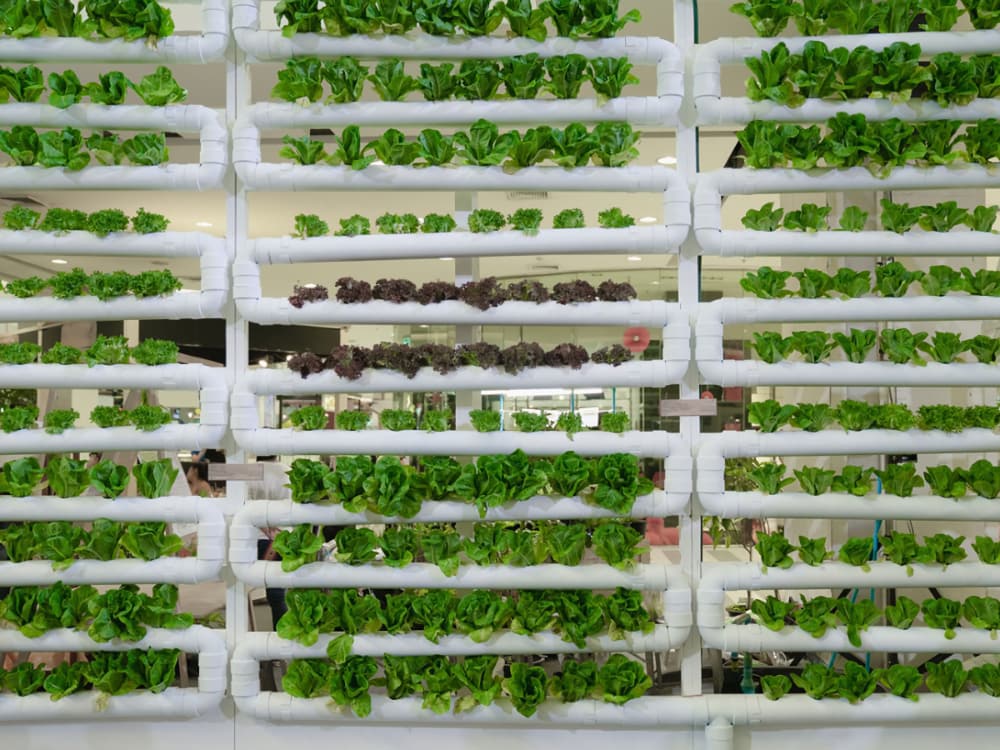
Nexton is one of a few companies who have embraced vertical farming. They also have chosen to utilize hydroponics systems to ensure they can grow food in the least favorable conditions. Nexton is a high-tech farm located in North Chungcheong, South Korea. In that area of the world, extreme weather conditions are common. And those weather changes create a challenge when it comes to growing food. Nexton knew they could help continue to produce food with their innovative ways of thinking.
This company’s work began back in 2017. That is when they chose to lease the old Okcheon Tunnel. The tunnel had been constructed back in 1970 to be used as a major highway. However, the tunnel was closed back in 2002 due to the steep curve. Instead of leaving the tunnel sitting there vacant, Nexton chose to use it to their advantage.
The tunnel is two thousand feet long. Inside the tunnel is perfect when it comes to growing conditions. Since the tunnel is completely dark, it is simple for workers to provide the proper amount of artificial light to each type of plant. And with temperatures staying steady between ten and twenty-two degrees Celsius, there is no need to adjust the inside temperature as often for what is best for the plants.
The vertical growth facilities of this high-tech farm allow Nexton to reduce the costs of growing food. The reason for this is they are growing much more in a smaller space since the plants grow vertically. All vertical farms have stacked beds for the plants. Those beds do not utilize soil or natural light. And since they go up, they don’t take up as much space on the ground.
Steps Nexton Uses for Their Farming Process
Automatic and Semi-Automatic Installation
Nexton managed to create an automatic and semi-automatic installation process. The line equipment works in conjunction with both the automatic seeding and automatic conveying system. Together, they all reduce production fatigue. They also improve the way the work is completed and reduce the cost of labor since not as many employees are needed to tend to the plants. Of course, optimal productivity was always the goal and Nexton achieved that with these processes.
Artificial Lights
Nexton didn’t want just any growing lights in their hydroponics systems farm. So, they developed their artificial lights in house. Every component, from the PAR, Photosynthetically Active Radiation, chip to the regulating optimum light wavelength board was designed by members of their team. The result was artificial lights that maximize the growth of every individual plant.
The artificial lights are LED that emit a pink glow. That pink color is from the spectrum of light that all plants use to photosynthesize.
ICT Technology Specialized in Crop Cultivation
This circulating nutrient system continuously checks the status of the nutrient rich solution in real time. Individual checks can also be completed if it is thought that a single system is not working properly. This piece of technology also creates a wastewater free discharge system.
Structural Design with Automation Technology
The automation technology Nexton uses was discussed a little above. However, it is the structural design that truly makes the automation technology work so well. Nexton’s structural design is patented and solves the inefficiencies that normally occur during multi-stage cultivation. This design also ensures there is minimal temperature rise from any heat produced from the LED waste.
Air Conditioning Technology
Controlling the temperature inside the old tunnel is simpler than controlling the outdoor temperatures throughout the year. However, there is still the need to make sure the temperature and humidity are ideal for the plants that are currently growing.
The Sound of Music
The one slightly unusual feature of Nexton’s high-tech farm is classical music is played inside the tunnel. According to the CEO of the company, Choi Jae-bin, Beethoven and Schubert are two composers whose music encourages the plants to grow faster.
Why Vertical Farming is Becoming More Popular
Water shortages, erosion of soil, and global warming are all reasons why vertical farming in becoming so popular in certain parts of the world. Another reason is lack of space. Farms used to be thousands of acres years ago. Nowadays, farmers need to sell off parts of their land, which means they have less space to work with for gardening.
Traditional farms are also no longer seen as environmentally friendly. The vehicles needed to harvest crops in larger areas burn too many fossil fuels. Add in the massive amounts of water needed for the crops and it is clear why vertical farming is becoming a necessity.
Some farmers are struggling with the vertical farming concept though. Some can’t maintain the controlled environment needed to grow plants vertically. Others say the use of artificial lights takes too much energy. And then there are those people who want to grow everything vertically, but the expertise needed hasn’t been acquired yet.
Currently, Nexton is growing sixty different types of fruits and vegetables in their vertical farming tunnel. All that produce is not covered with chemicals, or other harmful ingredients, since it was all grown inside. This is just a small portion of the foods that will need to be grown in this way by the year 2050. With the world’s population being predicted to reach almost ten billion by that time, farming space is going to be almost non-existent.
Therefore, it isn’t surprising that other companies, and people, are embracing hydroponics systems and vertical growing for all their gardening needs. According to the CEO of Nexton, the future will bring plants growing inside homes, at restaurants, and even at transportation stations. There is an endless supply of options, even though space will be limited.
Nexton seems to have the leading edge when it comes to vertical farming and utilizing hydroponics systems for gardening. Others should look towards them for guidance for growing food in such a way that limited space is needed for larger harvests. After all, it is how the future is looking for farming.
If you liked this article, you will like our Green Roofs Guide post.




